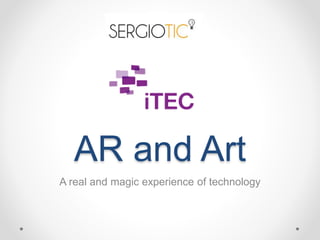iTEC Augmented Reality and Art - Sergio G Cabezas
- 1. AR and Art A real and magic experience of technology
- 4. Who I am • @sergiotic • Lecturer at CSEU La Salle and Universidad Autónoma de Madrid. • phD student: Influence of interactive boards and augmented learning enviroments in teacher training. • SMART Exemplary Educator • CEO of Possible Lab • Geek, sci-fi fan, e-life learner, art lover.
- 5. My objetives • Learn how to make a live painting with Augmented Reality. • Motivate (teachers, students) to use AR in the classroom • Make people concious of the ease of this technology
- 6. A little introduction To understand this madness
- 7. The idea
- 13. Materials and competences What do I need?
- 14. Scenario A • HD camera • Tablet • Tripod • Professional chroma key YES High IT Level YESMedium IT Level NO Low IT Level + 1000 €
- 15. Scenario B • Smartphone • Tablet (optional) • Handmade chroma key YES High IT Level YESMedium IT Level MAYBE Low IT Level 50-100€
- 16. Scenario C • Smartphone • A lot of creativity, painting and time :D YES High IT Level YESMedium IT Level YES Low IT Level 50-100 €
- 17. Step by step Because it´s so easy
- 18. 1st Step: The project • Project-based workshop • Divide into groups • Choose a painting • Make a research about the painting, the author or the historical situation. • Elaborate a script
- 19. 2nd Step: preparation • Prepare the studio • Establish roles (actors, technicians and assistants) • Find proper clothing. • Rehearse the play.
- 20. 3rd Step: the play • Do it until you have it!
- 21. 4th Step: video making • Choose a video program o iMovie o Movie Maker o Final Cut o Adobe Premiere • Choose an audio program o Audacity • Let´s make the video
- 22. The Fable of Arachne Diego de Velázquez
- 23. The Milkmaid – Johan Veermer
- 24. Don Sebastian de Morra – Diego de Velázquez
- 25. 5th Step: QR Codes • Upload the video to youtube, vimeo or similar • Glue the URL of the video to a QR Code. • Print the painting • Print the QR Code • Set up an exhibition with it. This option is perfect for lower IT level teachers.
- 26. 5th Step: Markless AR • Sign up in studio.aurasma.com • Make the auras o Trigger image o Overley o Public Channel • Print the painting and instructions to see the auras. • Set up an exhibition with it. This option is better but more difficult.
- 27. Volunteers • 2 beautiful cherubins • 1 sound manager • 1 video manager • 2 actor assistants • 2 scenery managers • 1 script manager
- 28. • All iTEC project (specially Will Ellis for the opportunity). • Ainhoa Marcos from SMART Tech. • CSEU La Salle. • To all my students, who have demonstrated that with creativity and belief, everything is possible. • To Raphael Sanzio, Leonardo da Vinci, Diego de Velazquez, JoaquĂn Sorolla, Monet, Berthe Morisot and the others for adding a touch of color to a sometimes too gray Europe. Thanks





























